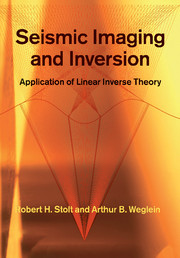Book contents
- Frontmatter
- Contents
- Preface and acknowledgments
- 1 Introduction – modeling, migration, imaging, and inversion
- 2 Basic migration concepts
- 3 Prestack migration
- 4 Migration limitations
- 5 Models for wave propagation and reflection
- 6 Green's functions
- 7 The scattering potential
- 8 Reflectivity
- 9 Synthesizing reflection data
- 10 Frequency–wavenumber migration
- 11 Asymptotic modeling and migration
- 12 Residual asymptotic migration
- 13 Asymptotic data mapping and continuation
- 14 Least-squares asymptotic migration
- Appendix A Conventions and glossary of terms
- Appendix B Coordinates, vectors, and identities
- Appendix C Fourier and Radon transforms
- Appendix D Surface and pointwise reflectivity
- Appendix E Useful filters
- Appendix F The phase integral and the stationary phase approximation
- Appendix G The diffraction integral
- Appendix H Wave-based, ray-based, and reflector-based coordinates
- References
- Index
Appendix A - Conventions and glossary of terms
Published online by Cambridge University Press: 05 February 2012
- Frontmatter
- Contents
- Preface and acknowledgments
- 1 Introduction – modeling, migration, imaging, and inversion
- 2 Basic migration concepts
- 3 Prestack migration
- 4 Migration limitations
- 5 Models for wave propagation and reflection
- 6 Green's functions
- 7 The scattering potential
- 8 Reflectivity
- 9 Synthesizing reflection data
- 10 Frequency–wavenumber migration
- 11 Asymptotic modeling and migration
- 12 Residual asymptotic migration
- 13 Asymptotic data mapping and continuation
- 14 Least-squares asymptotic migration
- Appendix A Conventions and glossary of terms
- Appendix B Coordinates, vectors, and identities
- Appendix C Fourier and Radon transforms
- Appendix D Surface and pointwise reflectivity
- Appendix E Useful filters
- Appendix F The phase integral and the stationary phase approximation
- Appendix G The diffraction integral
- Appendix H Wave-based, ray-based, and reflector-based coordinates
- References
- Index
Summary
Conventions
Vector conventions Vector quantities appear in bold-face type (e.g. x). Two-dimensional projections of threedimensional vectors are given a ∼ overhead, as in x = (x, y), as a projection of x = (x, y, z). Matrices are represented as bold-face capitals.
Operator argument conventions
Some quantities can be viewed as operations which map a set of input coordinates onto a set of output coordinates. We represent such quantities with the form D (xg|xs;t). The xs is placed right of the vertical bar to indicate that it is an input coordinate, while the xg is placed left of the vertical bar to indicate that it is an output coordinate. The t is placed on the far right to separate it from the input and output coordinates. We could define a source time as an input coordinate and a measurement time as an output coordinate but, since we consider only the difference between these two times to be important, have chosen not to. Our notation is analogous to a generalized matrix notation in which the receiver locations xg indicate rows and the source locations xs indicate columns. Were we to employ Dirac notation (commonly used in physics), D (xg|xs; t) would become 〈xg|D(t)|xs). Though better in many respects, Dirac notation is not in common use within the geophysics community, so we refrain from using it in this volume.
- Type
- Chapter
- Information
- Seismic Imaging and InversionApplication of Linear Inverse Theory, pp. 306 - 310Publisher: Cambridge University PressPrint publication year: 2012



